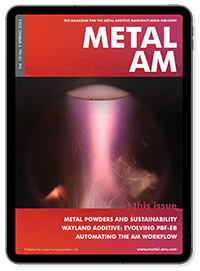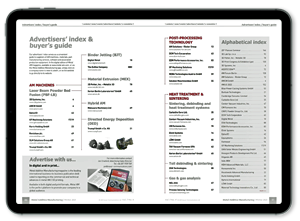Binder Jetting’s position as an accepted mass production technology for precision metal components is on the near horizon. The coming success will, however, rely as much on expertise in the sintering process as it does on expertise in jetting binder onto a powder bed to make ‘green’ parts. This article reports on how GKN Powder Metallurgy’s Additive Manufacturing division, GKN Additive, has leveraged decades of sintering expertise in high-capacity continuous furnaces, combined with its application development expertise, to deliver the series production of special filters by Binder Jetting for Schneider Electric.
... Read more »
General Atomics Aeronautical Systems, Inc. (GA-ASI) is the world leader in the design and manufacture of Unmanned Aircraft Systems (UAS). The company is no stranger to AM, with its Additive Design and Manufacturing Center of Excellence being integral to the qualification of more than 300 AM flight components and the installation of more than 10,000 AM parts on its aircraft. Now, it is working to identify and partner with some of the most innovative players in the industry in order to further leverage the capabilities of the technology. Divergent Technologies, the company behind Czinger Vehicles, is one such company. Jeff Kerns reports for Metal AM magazine.
... Read more »
Kennametal is a particularly interesting company when it comes to the adoption of Additive Manufacturing. It is a dynamic global producer of tooling and industrial materials with sales of $2 billion in 2022, yet its roots are very much in ‘old school’ sinter-based PM processes. It is, therefore, no surprise that the company was an early adopter of AM, leveraging its materials and sintering expertise, as well as its broad customer base, to develop a leading position in the AM of hardmetals and steels. Bernard North, who fortuitously happens to be a past VP Industrial Technology at Kennametal, visited the company’s AM operation and reports for Metal AM magazine.
... Read more »
Thanks to a new generation of compact metal Additive Manufacturing machines optimised for dental laboratories, combined with software improvements and optimised workflows, AM technology is now being more widely implemented in medium- to large-sized dental laboratories. In this article, Stijn Hanssen, Director, Dental Applications & Business Development, 3D Systems, reports on the application of metal AM technology for digital dentistry, reducing labour costs, maximising productivity and providing faster outcomes for patients.
... Read more »
So much is discovered when it just all goes wrong. From a ‘design-fail-fix’ perspective, it’s expected that developmental components may be pushed to destruction. With rocket engines that operate near the limits of their performance, however, the need to understand the causes of a failure is critical. In the competitive commercial space business there’s a clear advantage not to disclose knowledge gained from such incidents. Thankfully, NASA can share what others cannot. Here, Alison Park, Deputy Technical Fellow, Materials and Additive Manufacturing, and Paul Gradl, Principal Engineer, share insights into one failure.
... Read more »
When NanoAL, LLC, a company with a decade of aluminium alloy development experience, decided to speed up its development of alloys for AM, it turned to SLM Solutions’ SLM®125 PBF-LB machine. As NanoAL’s Matthew Simmers explains, the company needed a workhorse machine that fulfilled a number of requirements, from open parameters and material flexibility to specifications and build quality that closely mirrored larger, production-focused machines. This article explores machine choice, installation, and operation in supporting NanoAL’s Rapid Alloy Screening (RAS) process.
... Read more »
While most people associate the advantages of AM with small- to medium-sized, complex parts, wire-based Directed Energy Deposition (DED) makes it possible to achieve geometric complexity on a huge scale. Although the adoption rate for wire-based DED does not come close to that of the more widely known metal AM processes, this unique technology has advanced dramatically over recent years, and promises major advantages in a volatile global manufacturing landscape. Dr Filomeno Martina, CEO and co-founder of WAAM3D, explains more.
... Read more »
Many in the Additive Manufacturing industry have spoken on the importance of taking a holistic view of the workflow, from powder production to part finishing. Viewing the workflow in this way enables a systems engineering approach, joining the complex machines and processes involved in AM together. But what if we were able to combine steps from across the AM workflow? What cost, time and safety improvements might that enable? John Barnes presents his DirectPowder™ process, developed in partnership with Christopher Aldridge. [First published in Metal AM Vol. 8 No. 3, Autumn 2022]
... Read more »
For Additive Manufacturing to succeed in the volume production of components for the mainstream automotive industry, it will not only require the creation of an effective AM culture within automotive producers, but also a radical re-evaluation of what different industries need from AM machine manufacturers. Jeff Kerns visited GM’s Additive Industrialization Center (AIC), in Warren, Michigan, USA, for Metal AM magazine and spoke at length with the centre’s team about its role in the exploration of AM for automotive, and how new machine designs will increase AM’s success in the automotive industry. [First published in Metal AM Vol. 8 No. 3, Autumn 2022]
... Read more »
It is too easy to look at metal Additive Manufacturing technologies as neatly fitting into a small number of convenient process categories. The risk, in doing so, is that the best solution could be overlooked. One AM process that does not fit into such neat boxes is Xerox’s Liquid Metal Jetting. Whilst it falls, broadly, under the ISO/ASTM 52900:2015 category of Material Jetting, it is unique among metal AM processes. Here, Bender Kutub considers where it fits into the drive for supply chain resilience, and explores its market potential. [First published in Metal AM Vol. 8 No. 2, Summer 2022]
... Read more »
Some companies have bolder missions than others. Whilst Elon Musk leverages metal Additive Manufacturing to transform space exploration, the founders of PrinterPrezz, Alan and Alexis Dang, Kishore Karkera and Shri Shetty, are aiming to do something equally bold with the same technology: bring safe, affordable, right-fit medical implants to the 97% of the world that can’t currently access them. Todd Grimm interviewed Alan Dang and Shri Shetty to discover more. [First published in Metal AM Vol. 8 No. 2, Summer 2022]
... Read more »
Every so often, something comes along that gets the whole Additive Manufacturing industry talking. Over the past two years, few companies have generated as much intrigue as Seurat Technologies, the Lawrence Livermore National Laboratory spin-out named for the French pointillist, bringing with it a technology roadmap that promises to evolve metal AM to the crucial point of out-competing conventional manufacturing methods. In this Metal AM exclusive, James DeMuth, Seurat CEO, offers the deepest look yet into the technology behind his company’s promise. [First published in Metal AM Vol. 7 No. 1, Spring 2022]
... Read more »





Join our community